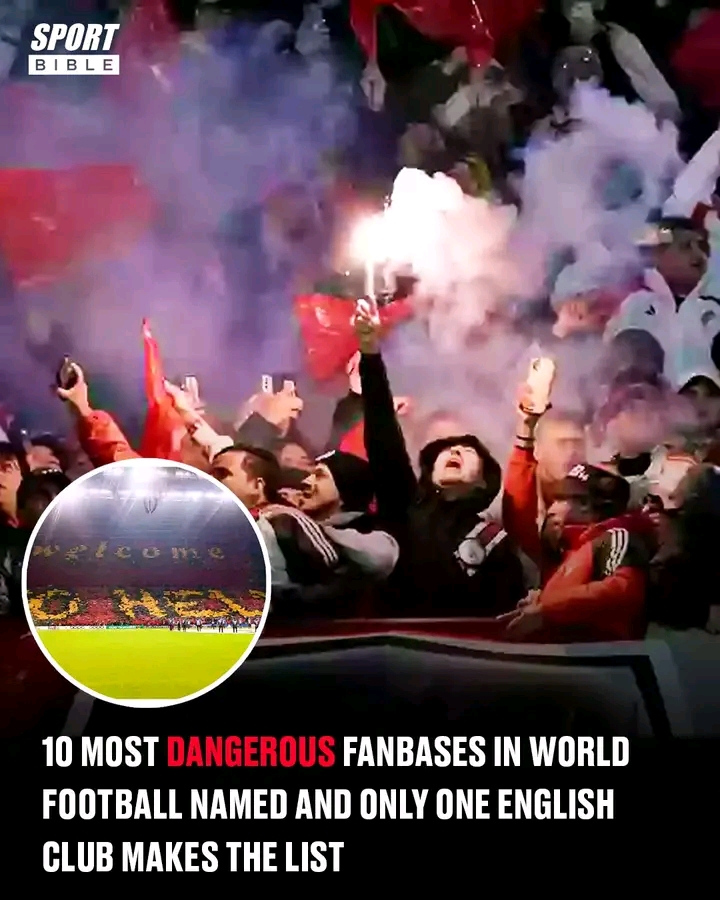10 most dangerous fanbases in world football named and only one English club makes the list

Football fans can be passionate but sometimes that passion turns dangerous with violence and chaos at matches. The world has seen some extreme fan behavior in stadiums from ultras carrying flares to organized hooligan firms causing trouble. According to Bleacher Report back in 2018 these are the 10 most dangerous football fanbases worldwide with only one English club making the cut. Wisla Krakow fans from Poland have built a reputation for violence and intimidation at matches creating hostile environments for visiting teams. Sparta Prague supporters from Czech Republic also made the list due to their aggressive behavior and various controversial incidents during matches. River Plate from Argentina has some of the most feared ultras in South America known for coordinated attacks and dangerous stadium atmospheres. Universitario de Deportes from Peru is another South American club whose fans have been involved in serious violence both inside and outside stadiums.
Millwall is the only English club on the list with their supporters known as the Bushwackers being one of the most notorious hooligan firms in football history. Although English football hooliganism isn’t as bad as it was in the 70s and 80s Millwall still carries a frightening reputation. Their fans regularly fought with rivals West Ham and Chelsea causing major riots and organized chaos on matchdays. AS Roma supporters from Italy made the list because of multiple stabbing incidents involving English clubs when they visited Rome for European matches. The report mentions that modern Roma fans can be likened to the ancient mob with emotions completely dependent on whether their team wins or loses.
Galatasaray fans from Turkey are among the most feared in world football famous for their welcome to hell slogan when teams visit their stadium. The deafening noise and intimidating atmosphere they create makes it a dreaded trip for away teams. A specific incident with Leeds United fans during the 2000 UEFA Cup semifinal is referenced as an example of the dangers they pose. Three national teams also appear on the list with Colombia El Salvador and Honduras fans all known for extreme passion that sometimes turns violent at international matches. Egyptian clubs Al Masry and Al Ahly are included after their fans were involved in one of the worst football disasters in history when violence between supporters led to many deaths.
Football should be about joy and bringing people together but unfortunately hooliganism still exists in many places. Ultras with their pyrotechnics and organized displays can create amazing atmospheres but sometimes cross the line into dangerous territory. Many clubs have tried to address these issues with varying success but certain fanbases still carry reputations for threatening behavior. While modern football has better security and safety measures the passionate nature of the game means emotions can still boil over in dangerous ways. International fixtures sometimes bring out nationalist tensions and rivalries that extend beyond just supporting a team.
Stadium safety has improved dramatically since the dark days of hooliganism but incidents still occur regularly in certain countries. European competitions sometimes see the worst behavior as fans travel abroad and clash with local supporters. Police forces around the world have specialized units dedicated to football violence which shows how serious the problem remains. Football authorities continue to implement stricter punishments for clubs whose fans misbehave but eliminating the problem completely seems impossible. The tribal nature of football support means intense rivalries will always exist sometimes carrying dangerous undercurrents.
Millwall fans in England have embraced their bad reputation with the famous chant no one likes us we dont care showing their defiance against public opinion. Italian ultras have highly organized structures almost like military operations with leaders and specific roles within their groups. Turkish football creates some of the most visually impressive displays with coordinated chanting and pyrotechnics but this passion can easily turn dangerous. South American football has deeply political connections with ultras often having ties to political movements or even criminal organizations. Eastern European clubs like those from Poland and Czech Republic have seen increasing ultras culture since the fall of communism.
Football authorities struggle to balance allowing passionate support while preventing dangerous behavior. Many clubs have banned items like flares and fireworks but fans still smuggle them into stadiums. Security measures like separated fan sections and police escorts for away supporters have become standard practice in high risk fixtures. Despite improved measures major incidents still occur occasionally reminding everyone of the dangers that exist. Social media has added new dimensions to football rivalries with online abuse sometimes translating to real world violence.
The report highlights how football violence differs across regions with each country having unique characteristics to their hooligan problems. English hooliganism peaked decades ago but its historical reputation still influences perceptions today. Italian ultras are known for using weapons particularly knives in planned attacks away from stadiums. Turkish fans create intimidating atmospheres through noise and visual displays that can psychologically affect visiting teams. South American violence often has deeper social and economic factors contributing to tensions in stadiums. Eastern European supporters frequently display racist behavior alongside violence making their reputation especially problematic.
Football culture varies dramatically across different countries with some places celebrating the ultra lifestyle while others work hard to eliminate it. Family sections and improved facilities have helped many clubs attract different types of supporters changing the atmosphere at matches. Authorities use banning orders and surveillance to identify and remove troublemakers from football. Despite progress the list shows dangerous elements still exist within fan cultures worldwide. The one English club making the list shows how British football has worked to address its previously notorious reputation.
Football should be enjoyed safely by everyone with passion expressed in positive ways rather than violence and intimidation. Unfortunately the history of the sport includes dark chapters of fan behavior that continue to influence perceptions today. The most dangerous fanbases mentioned have caused real harm to people simply trying to enjoy watching their teams play. Modern football governance continues working to eliminate these dangerous elements while preserving the atmosphere that makes the sport special. The passion for football worldwide remains incredible but must be channeled appropriately to keep everyone safe when attending matches.















